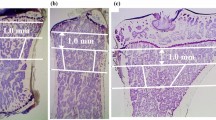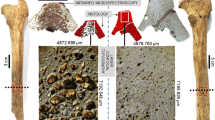Summary
We measured bone osteocalcin concentrations in EDTA extracts from iliac crest cortical bone specimens obtained postmortem from 63 men and 71 women (age range 19–90 years), and serum osteocalcin levels in healthy blood donors, 49 men and 49 women (age range 21–65 years). Bone and serum osteocalcin concentrations were higher in men than in women, and an age-related decline was observed in both sexes. In women, however, a temporary increase in serum (P<0.05) osteocalcin was seen in the sixth decade. This study shows sex- and age-related changes in bone osteocalcin consistent with changes in serum osteocalcin, confirming that serum measurement of osteocalcin reflects bone levels. As osteocalcin reflects osteoblastic activity and thus bone formation, the overall decline in bone and serum osteocalcin in men and women, and the increase in serum osteocalcin in the sixth decade in women, indicate that aging is associated with a decrease in bone formation and turnover and that osteoblastic activity and bone turnover are stimulated at the menopause.
Similar content being viewed by others
References
Delmas PD, Stenner S, Wahner HW, Mann KG, Riggs BL (1983) Increase in serum bone gamma-carboxy-glutamic acid protein with aging in women. J Clin Invest 71:1316–1321
Epstein S, McClintock R, Bryce G, Poser J, Johnston CC, Hui S (1984) Differences in serum bone gla proteins with age and sex. Lancet i:307–310
Price PA, Parthermore JG, Deftos LJ (1980) A new biochemical marker for bone metabolism. J Clin Invest 66:878–883
Gundberg-Carpenter C, Aronoff J, Gallop P (1985) The clinical usefulness of serum osteocalcin measurements. In: Butler WT (ed) The chemistry and biology of mineralized tissues. Birmingham, E BSCO Media, pp 411–415
Gevers G, Devos P, De Roo M, Dequeker J (1986) Increased levels of osteocalcin in rheumatoid arthritis. Br J Rheumatol 25:260–262
Gundberg CM, Hauschka P, Lian JB, Gallop PM (1984) Osteocalcin: isolation, characterization and detection. In: Moldave K (ed) Methods in enzymology. Academic Press, New York, pp 516–544
Price P, Nishimoto J (1980) Radioimmunoassay for the vitamin K-dependent protein of bone and its discovery in plasma. Proc Natl Acad Sci USA 77:2234–2238
Galli M, Caniggia M (1985) Osteocalcin in normal adult humans of different sex and age. Horm Metab Res 17:165–166
Duda RJ, O'Brien JF, Katzmann JA, Peterson JM, Mann KG, Riggs BL (1988) Concurrent assays of circulating bone Gla-protein and bone alkaline phosphatase: effects of sex, age and metabolic bone disease. J Clin Endocrinol Metab 66:951–957
Catherwood BD, Marcus R, Madvig P, Cheung AK (1985) Determinants of bone gamma-carboxyglutamic acid-containing protein in plasma of healthy aging subjects. Bone 6:9–13
Dandono P, Menon RK, Shenoy R, Houlder S, Thomas M, Mallinson WJ (1986) Low 1,25 dihydroxyvitamin D, secondary hyperparathyroidism and normal osteocalcin in elderly subjects. J Clin Endocrinol Metab 63:459–462
Geusens P, Dequeker J, Verstraeten A, Nijs J (1986) Age-, sex- and menopause-related changes of vertebral and peripheral bone: population study using dual and single photon absorptiometry and radiogrammetry. J Nucl Med 27:1540–1549
Nishimoto SK, Price PA (1980) Secretion of the vitamin K-dependent protein of bone by rat osteosarcoma cells. J Biol Chem 255:6579–6583
Duda RJ, Kumar R, Nelson KI, Zwismeister AR, Mann KG, Riggs BL (1987) 1,25-dihydroxyvitamin D stimulation test for osteoblastic function in normal and osteoporotic post-menopausal women. J Clin Invest 79:1249–1253
Lian JB, Gundberg CM (1988) Osteocalcin. Biochemical considerations and clinical applications. Clin Orthop Rel Res 226:267–291
Melick RA, Farrugia W, Quelch KJ (1985) Plasma osteocalcin in man. Aust NZ J Med 15:410–416
Author information
Authors and Affiliations
Rights and permissions
About this article
Cite this article
Vanderschueren, D., Gevers, G., Raymaekers, G. et al. Sex- and age-related changes in bone and serum osteocalcin. Calcif Tissue Int 46, 179–182 (1990). https://doi.org/10.1007/BF02555041
Received:
Revised:
Issue Date:
DOI: https://doi.org/10.1007/BF02555041




